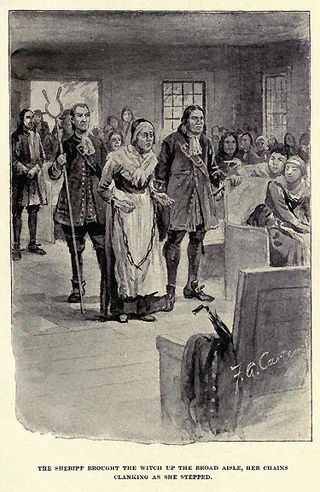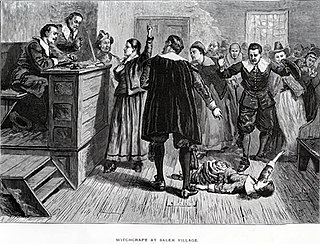
The Crucible is a 1953 play by the American playwright Arthur Miller. It is a dramatized and partially fictionalized story of the Salem witch trials that took place in the Massachusetts Bay Colony during 1692–93. Miller wrote the play as an allegory for McCarthyism, when the United States government persecuted people accused of being communists. Miller was questioned by the House of Representatives' Committee on Un-American Activities in 1956 and convicted of contempt of Congress for refusing to identify others present at meetings he had attended.

The Salem witch trials were a series of hearings and prosecutions of people accused of witchcraft in colonial Massachusetts between February 1692 and May 1693. More than 200 people were accused. Thirty people were found guilty, nineteen of whom were executed by hanging. One other man, Giles Corey, died under torture after refusing to enter a plea, and at least five people died in jail.
Elizabeth "Betty" Parris was one of the young girls who accused other people of being witches during the Salem witch trials. The accusations made by Parris and her cousin Abigail Williams caused the direct death of 20 Salem residents: 19 were hanged, while another, Giles Corey, was pressed to death.
John Proctor was a landowner in the Massachusetts Bay Colony. He and his wife Elizabeth were tried and convicted of witchcraft as part of the Salem Witch Trials, whereupon he was hanged.
Ann Putnam was a primary accuser, at age 12, at the Salem Witch Trials of Massachusetts during the later portion of 17th-century Colonial America. Born 1679 in Salem Village, Essex County, Massachusetts Bay Colony, she was the eldest child of Thomas (1652–1699) and Ann Putnam (1661–1699).

John Hale was the Puritan pastor of Beverly, Massachusetts, and took part in the Salem witch trials in 1692. He was one of the most prominent and influential ministers associated with the witch trials, being noted as having initially supported the trials and then changing his mind and publishing a critique of them.
Elizabeth Proctor was convicted of witchcraft in the Salem Witch Trials of 1692. She was the wife of John Proctor, who was convicted and executed.

Samuel Parris was the Puritan minister in Salem Village, Massachusetts, during the Salem witch trials. Accusations by Parris and his daughter against an enslaved woman precipitated an expanding series of witchcraft accusations.

Tituba was a Native American? slave woman who was one of the first to be accused of witchcraft during the Salem witch trials of 1692–1693.

Sarah Good was one of the first three women to be accused of witchcraft in the Salem witch trials, which occurred in 1692 in colonial Massachusetts.
Rebecca Blake Eames was among those accused of witchcraft during the Salem witch trials of 1692.

Rebecca Nurse was a woman who was accused of witchcraft and executed by hanging in New England during the Salem Witch Trials of 1692. She was fully exonerated fewer than twenty years later.
Roger Toothaker was a physician from Billerica, Massachusetts who was accused of witchcraft during the Salem witch trials in May 1692. He was sent to Boston Jail where he died the following month.
This timeline of the Salem witch trials is a quick overview of the events.

Sarah Wildes was wrongly convicted of witchcraft during the Salem witch trials and was executed by hanging. She maintained her innocence throughout the process, and was later exonerated. Her husband's first wife was a member of the Gould family, cousins of the Putnam family, the primary accusers, and court records document the family feuds which led to her persecution.
Elizabeth Hubbard is best known as the primary instigator of the Salem Witch Trials. Hubbard was 17 years old in the spring of 1692 when the trials began. In the 15 months the trials took place, 20 people were executed.
Abigail Faulkner, sometimes called Abigail Faulkner Sr., was an American woman accused of witchcraft during the Salem witch trials in 1692. In the frenzy that followed, Faulkner's sister Elizabeth (Dane) Johnson (1641–1722), her sister-in-law Deliverance Dane, two of her daughters, two of her nieces, and a nephew, would all be accused of witchcraft and arrested. Faulkner was convicted and sentenced to death, but her execution was delayed due to pregnancy. Before she gave birth, Faulkner was pardoned by the governor and released from prison.
Sarah Cloys/Cloyce was among the many accused during Salem Witch Trials including two of her older sisters, Rebecca Nurse and Mary Eastey, who were both executed. Cloys/Cloyce was about 50-years-old at the time and was held without bail in cramped prisons for many months before her release.

Margaret Scott was found guilty of witchcraft during the Salem witch trials and was executed by hanging on September 22, 1692. She was part of the last group to be executed, which also included Mary Eastey, Martha Corey, Ann Pudeator, Samuel Wardwell, Mary Parker, Alice Parker, and Wilmot Redd. She was the only accused person from Rowley to be executed. As a lower-class, long-term widow, having lost several children in infancy, she was a prototypical witch candidate. When her husband, Benjamin, died, he left a very small estate and she, being unable to remarry, was reduced to begging, which invited resentment and suspicion. In this manner, her circumstances were comparable to fellow victim Sarah Good.

Martha Carrier was a Puritan accused and convicted of being a witch during the 1692 Salem witch trials.










